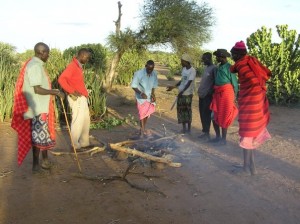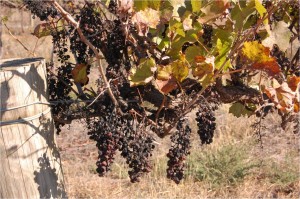“By 2025, 1.8 billion people will be living in countries or regions with absolute water scarcity, and two-thirds of the world’s population could be living under water stressed conditions. The lack of water limits farmers’ ability to produce enough food to eat or earn a living.” – UN World Water Day 2012 website

One man roasting a goat, six others giving direction. Borrowed from Lizzie King, who has spent many years studying rangeland restoration with the Maasai of Kenya.
Water and Food Security is the theme of World Water Day – March 22nd, 2012. Every food crop, all meat production, and inland fisheries from Amsterdam to Zanzibar depend on water.
Here, food security once meant the annual migration of millions of sockeye, traveling up the Okanagan River. Fish, wild berries, and game were reliable food for Okanagan peoples for millennia. Now, with 300,000 people in the valley, food security is (like most other places) mostly about land and irrigation water.
I moved to the Okanagan because of the fruit: piles of peaches imprinted in childhood memories – hauling crates home for canning. When offered a job here, I remembered the fruit, the land of plenty, and came back. But this oasis is a gift of irrigation. Looking up hill past the vineyards, it’s all sagebrush, pine, and bunch grass. The lake is big, but the land is dry.
When the first Okanagan real estate barons arrived, they put in flumes and ditches, subdivided, and sold farm properties to dreamers in Ontario: “Summerland” and “Peachland” were planned developments, built on the dream of unlimited water and sun to grow fruit. The cities and towns grew up around the irrigation systems.
Right now, BC farmers grow half the food for the province, but only about 35% of the fruit and vegetables. The rest comes from away: California, Chile, and China. To grow more – to grow enough to even keep up with BC’s population growth – will take much more irrigation. In the Okanagan, we’ll have to irrigate more land, with potentially less water.
The UN suggests that, on a global level, we should be shifting to less water-intensive food sources – less meat, and less flood-irrigated rice. This makes sense in theory, but in practice it’s a struggle in areas with expensive land. Farmers need to maintain economic viability, and in BC this sometimes means growing (more water intensive) apples and hay, instead of grapes and range-fed livestock. If farms go out of business, the availability of farmland will gradually be eroded by the forces of the market, eroding our ability to produce food in the future.
Instead of changing crops, in the Okanagan there is a big push to improve irrigation systems. Partly, this means fixing leaky pipes and putting in drip irrigation where it’s practical. Even more important is to irrigate smarter – training irrigation designers, developing irrigation calculators, and training farmers to avoid over-watering.
Visiting Australia, it was an eye-opener to see sensors, meters, and gauges at almost every farm. There was a grape-glut on, and if you wanted to sell your crop, the vines needed the exactly right amount of water deprivation: no more, no less.
The BC Agriculture Council wants an Agricultural Water Reserve included in the newly-revised Water Act to secure water for land in the Agricultural Land Reserve. The fear is that water will be taken from agriculture for green city lawns and to fill creeks without any cuts by urban users. This sentiment is everywhere, and long-standing. Driving through the Central Valley in California you pass billboard after billboard, “No Water, No Farms. No Farms, No Food.”
We (the OBWB) have a small project this year to model out what an Agricultural Water Reserve would look like in the Okanagan – a feasibility study of how it would work with our geography and water distribution systems.
The central point of World Water Day 2012 is that this is not a time for complacency. Not that we should panic – but despite the fact that we get most of our food elsewhere, there are more mouths everywhere, and less land and water to feed them with.
Trying to plan 20 or 50 years in the future, it feels a little presumptuous to assume a steady supply of rice from China or California, or that we can still get neatly-packed, $1.00 cans of tuna from the supermarket.
This Thursday, let’s celebrate our farmers. We are living in a fortunate corner of the planet, but we’re all going to have to work together on this one. With a little luck, we can help bring back the sockeye, too. Here’s another charming video about making Okanagan water work.





I asked you once before about California rice production and you said it was OK cause it is good for the birds. But I notice that in this entry you say, “The UN suggests that, on a global level, we should be shifting to less water-intensive… food sources – less meat, and less flood-irrigated rice. ” Based on what you know, is there a better use for the kind of land currently growing rice in Calif (very prone to flooding in winter months but dependent on irrigation and indirectly on snow pack during summer)?
Hi Julian,
Great question. Some parts of the world it is totally appropriate to grow rice. The California delta is one place where it makes a lot of sense. The land floods, and the rice fields are like giant managed wetlands that support great migratory bird populations.
When I visited Australia, we did a farm-stay with a rice-grower in a drought-prone area of New South Wales. There is a famous poem that calls Australia the land of “drought and flooding rains” (www.dorotheamackellar.com.au/archive/mycountry.htm). The farmers there adapt to variation in the weather by growing rice as an annual during wet years, and wheat or other crops during dry years. When we visited in May of 2010, he’d just harvested the rice (which had been flood irrigated), and said that there was enough water in the soil that he wouldn’t have to water his winter wheat crop at all. For him, rice is a cash crop that you grow when you can, but that you don’t rely on for your steady income.
The important thing is to match your crops to your conditions, and these can be environmental, economic, or social (availability and cost of labour). Not easy being a farmer in the 21st century, but I’m not sure if it has every been.
Pingback: Weddings, weird weather, and where to fit everyone - water, population growth and climate changeBuilding Bridges
This just in from the illimitable Hans Schreier, a Virtual Water App! http://wmc.landfood.ubc.ca/webapp/VWM